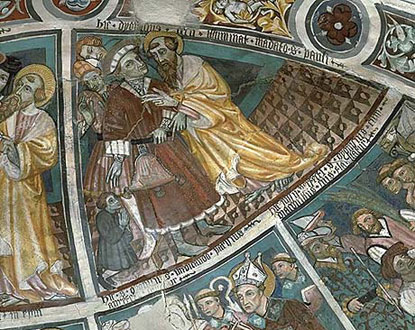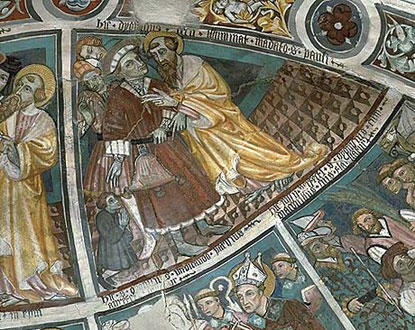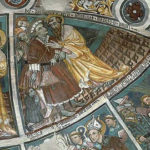Saint Etienne de Tinée is no longer in the maritime climate. From the Valabre gorge after the bridge of Paule, one enters the Alpine climate. The high peaks appear at the turns of the road that follows the winding river. The villages are no longer those eagle’s nests perched on the top of a hill. They stretch along the Tinée, nestled and surrounded by proud high alpine ridges licking the cerulean spaces.

The Chapel of Saint Roch, a saint with the same virtues as Saint Sebastian, is just a few steps away. It dates from the 17th century and is backed against a house. This is its curiosity. The question of the chicken and the egg arises, according to our guide, about them. Saint Etienne had a convent of the Trinitarians, today only the chapel remains. It is from the 17th century. N D du bon remède is invoked there. It houses several paintings from the 17th and 18th centuries, as well as a larch wood altarpiece from 1737. Its 1685 frescoes are types of ex-votos: healings, accidents, and even a scene from the Battle of Lepanto. In the past, there were depictions of saints Jean de Matha and Félix de Valois. They were covered up as they were dilapidated in 1837 before the visit of the Bishop of Nice, Mgr Galvano. These two saints had founded the Order of the Trinitarians to ransom captives from the Barbary pirates.
The medieval parish church was under the protection of Saint James the Greater. Only the Gothic chancel remains today, with its vaults above the high altar, as well as its Lombard bell tower. The latter is the oldest monument in the village. It is believed to date prior to the dedition of 1388, having the fleur-de-lis of France carved on one of its stones. Two other dates give us historical markers on the latter: 1492 and 1659. Originally, it did not have its octagonal spire and was used as a watchtower. Today’s church is of Romanesque Byzantine style, completed on December 4, 1789.
The Chapel of Saint Maur dates from the 16th century. It is located on the mule track that leads to the Auron plateau. Its frescoes are attributed to Andreade Cella. These represent the lives of Saint Sebastian and Saint Maur. Saint Erige in Auron is a Templar chapel from the 13th century. In the Middle Ages, it was inhabited by shepherds and the people of Saint Etienne who came there to make hay and harvests. Saint Erige was prayed to for stillborn children so that he might resurrect them long enough to anoint or baptize them. Erige was the Bishop of Gap, and he died in 603. Legend tells us that, returning from Rome and to escape bandits, his horse supposedly leaped over the valley and found itself on this plateau. The frescoes of Saint Erige date from 1451. They are among the most beautiful in the region of Nice. They narrate the lives of two saints: Erige and Denis, who was converted by Saint Paul. Saint Mary Magdalene is also depicted there as in the Chapel of Saint Sebastian. In the Middle Ages, frescoes were the means to transmit the faith to illiterate populations. It was through images, sorts of “comics,” that priests educated the people. To conclude this visit, we mention the book of Mireille Rovery “Mon clocher raconte” a woman from Stéphanoise passionate about the chapels of Saint Etienne.
Thierry Jan.



